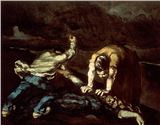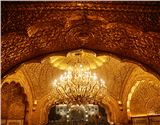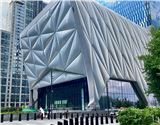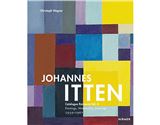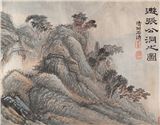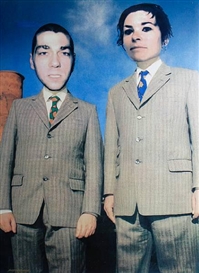Lights, Shadow,(Re)Action: Tim Noble and Sue Webster Trash Art
The works of edgy collaborators Tim Noble and Sue Webster range from effervescent, large-scale light installations to jaw-dropping sculptures made from materials like taxidermy animal parts, scrap metal and peanut butter. Even their website is decidedly nontraditional, in the deepest sense of the word: “Welcome, Motherfuckers!” is the greeting that welcomes visitors upon entry. Suffice it to say, everything about their multi-faceted artwork grabs your attention, and heaven help us, we just can’t stop looking.
MutualArt
Nov 16, 2011
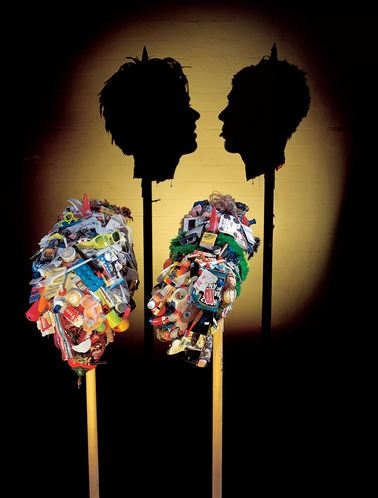

From left to right: Fucking Beautiful, 2002 (Snow White Version); The New Barbarians, 1997-1999; and Kiss of Death, 2003
Their works range from effervescent, large-scale light installations to graphic art illustrations, to jaw-dropping sculptures made from materials like taxidermy animal parts, scrap metal and peanut butter. Even their website is decidedly nontraditional, in the deepest sense of the word: “Welcome, Motherfuckers!” is the greeting that welcomes visitors upon entry. They’ve successfully done away with false politesse and formality, and remain staunchly unapologetic about this fact. Suffice it to say, everything about their multi-faceted artwork grabs your attention, and heaven help us, we just can’t stop looking.
We’re talking about British collaborative artists Tim Noble and Sue Webster, who first took the art world by storm nearly fifteen years ago, and the two show no signs of slowing down (nor would we ever want them to). Their creations play both literally and figuratively on the juxtaposing relationship between ‘light’ and ‘shadow’, so it’s fitting that these are the titles of their two main bodies of work. “Our work is incredibly unsocial,” Webster has said. “There has to be complete darkness because you need to give the light and then to take it away again.“

One of the pair's stellar large-scale light installations: Electric Fountain, 2008.
Their pretty, crowd-captivating light-installations explore a common thread that connects all of their varied masterpieces: investigating how people interpret abstract images through applied meaning. This is most evident in their cutting-edge “rubbish” sculptures (part of the shadow work), where the old adage “One man’s trash is another man’s treasure” rings especially true. Works are made from discarded objects and later assembled into innovative sculptures that leave audiences scratching their heads in “how do they do it?!” disbelief. Which, according to Webster, is one of the duo’s goals. “The main challenge is to find a way to maintain the suspension of disbelief,” the artist told MutualArt in a recent interview.
What’s so awe-inspiring about their work? These are collaborative pieces with manifold meanings. They please the eye two-fold, like optical illusions: there’s the sculpture itself and then the image it projects. And no, we’re not just speaking metaphorically here. Case in point: Check out their tantalizing fruit sculpture. 
It’s a triumvirate of meaning - the sculpture itself, the projected image, and the relationship between the two - eliciting a lot of gasps and ‘wow’s from even the most articulate art critics.
So just where in the world did Noble and Webster come up with this idea? We learned about their unorthodox artistic approach when we spoke with one half of the dynamic duo - Sue Webster was initially inspired to use nontraditional media after a particularly harrowing experience she had while in art school. Webster had intended to pursue a career in painting; at least, that was the plan when she enrolled in the fine art program at Nottingham Trent University in the late 80’s. Fate, it seemed, had another idea in mind. While visiting a music festival with her then-boyfriend, she had what can only be described as a very bad trip. “I consumed a very tiny and innocent looking pill called a micro dot, which turned out to be an extremely strong hallucinogenic,” Webster candidly explained. “I lost sight of [my] boyfriend, and so those terrible twins - ‘fear and paranoia’ - decided to take me by the hand and lead me on a 14 hour ‘fun’ ride.” The artist vividly remembers every detail of the ordeal:

Dirty White Trash (With Gulls), 1998. The work was composed from 6 months of artist's trash, 2 taxidermy seagulls, and a light projector. Even the double-entendre title alludes to the dual meaning of the work.
“The ground melted beneath my feet and I thought I was being swallowed up by the earth; my shoe laces turned into writhing fluorescent green snakes that began to wrap themselves around my legs; my pupils dilated to the size of two goldfish bowls and it seemed that everybody was peering knowingly at me through my inflated goggles. The apples on the trees that wore little Michael Jackson faces were talking to me, and I remember seeking refuge in the Samaritan’s tent (which was full of other acid casualties), and I became aware of every single molecule in the Earth’s atmosphere being like a three-dimensional paisley-patterned curtain. I paused for a moment to consider if this was Heaven or Prince’s Paisely Park...My peripheral vision narrowed, and I was aware of traveling down a dark tunnel with a bright light at the end that was calling to me.”

Soon after, the two began collaborating and the duality of their partnership is reflected in their art. In terms of their shadow works, we were curious to know which came first: the actual piece or the projected image it created? Webster isn’t sure of the exact moment of epiphany, but she says the idea stemmed from challenges the duo faced while working on one of their light sculptures. “I remember being frustrated whilst wiring an early work, Toxic Schizophrenia, as I had to wait for a shipment of bulbs or something, and the idea for the shadow sculptures came out of the desire to keep making,” she says. 
This innovative approach spiraled into a series of other “rubbish works” that played off of their light sculptures, and explored a subject that both Noble and Webster continue to address in their art - redefining how abstract forms can be transformed into figurative pieces and examining how people process these relationships. The artists use materials like scrap metal and cable wire, as well as less traditional media such as animal parts, cooking oil, and even urine. (Not for the faint of heart, animal parts are also the favored media of another innovative artist, Elpida Hadzi-Vasileva. Read our interview with her here.) Webster is undecided about which media she likes best. “What’s nice about working with different materials is that there is no direct way in which to join things together, so every new method is a totally new experimental experience which keeps the work fresh,” she explains. “I guess it’s obvious that one joins metal together by welding, but there exists no textbook explanation of how to join the body of a rat (something soft and furry) to the wing of a Rook.”

Metal Fucking Rats, 2006; Metal Fucking Rats with Heart-Shaped Tails, 2007

He/She (Diptych) 2004. Welded Scrap Metal, 2 light projectors.
Webster says the core relationship between the works and the projected images are the same, regardless of whether the medium is stuffed squirrel or sterling silver: “It’s the realization of one of the most avidly pursued artistic goals in modern and contemporary art - the fusion of representation and abstraction.” This fascinating fusion is explored pictorially in the appropriately titled British Rubbish, an art book recently released about Noble and Webster’s work from the past fifteen years, with essays by Jeffrey Deitch, Michael Bracewell and Nick Cave. (Below Left: Double Header Double Pleasure, 2000. Made from sex toys, wood and a light projector. Below Right: The Gamekeeper's Gibbet, 2011. Solid sterling silver gilded in pure gold, metal stand, light projector.)



Whatever media they choose - whether in light or shadow - Noble and Webster keep us captivated. Bloody Forever, 2011.
Images courtesy of the artist's website.
Written by MutualArt writer Lauren Meir


